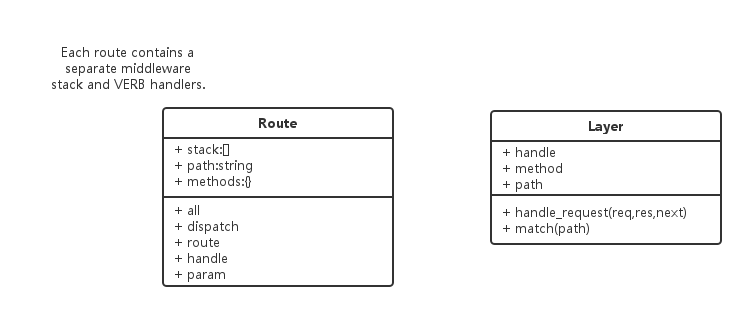这2天看了一点node+express的路由源码有了一点眉目,总结一下
对于app.get,
首先给出一张类图:

图1
注意每个路由有一个stack,这个stack中存放了Layer。
路由系统内有三个文件:

图2
其中layer.js,route.js即为图1中的类的模块。
application.js都只对外层router进行操作
外层路由针对中间件来说的,内层路由针对中间件的链路来说
在index.js中,我认为又对Route做了封装,下面是即为重要的工厂方法
proto.route = function route(path) {
//外层路由构建
var route = new Route(path);//创建内层Route var layer = new Layer(path, { sensitive: this.caseSensitive, strict: this.strict, end: true }, route.dispatch.bind(route)); layer.route = route;//每个外层layer引用一个内层路由 形成循环引用 this.stack.push(layer);
//将构建得到的layer加入外层stack return route; };
//外层route的所有HTTP谓词方法的实现
//
methods.concat('all').forEach(function(method){ proto[method] = function(path){ var route = this.route(path)//外层加一层 route[method].apply(route, slice.call(arguments, 1));//调用里层Router谓词 里层加一层 return this; }; });
app.lazyrouter = function lazyrouter() { if (!this._router) { this._router = new Router({ caseSensitive: this.enabled('case sensitive routing'), strict: this.enabled('strict routing') }); this._router.use(query(this.get('query parser fn'))); this._router.use(middleware.init(this)); } };
app.use中间件的实现,可见都用到了路由系统的use方法
app.use = function use(fn) { var offset = 0; var path = '/'; // default path to '/' // disambiguate app.use([fn]) if (typeof fn !== 'function') { var arg = fn; while (Array.isArray(arg) && arg.length !== 0) { arg = arg[0]; } // first arg is the path if (typeof arg !== 'function') { offset = 1; path = fn; } } var fns = flatten(slice.call(arguments, offset)); if (fns.length === 0) { throw new TypeError('app.use() requires middleware functions'); } // setup router this.lazyrouter(); var router = this._router; fns.forEach(function (fn) { // non-express app if (!fn || !fn.handle || !fn.set) { return router.use(path, fn);//外层路由 } debug('.use app under %s', path); fn.mountpath = path; fn.parent = this; // restore .app property on req and res router.use(path, function mounted_app(req, res, next) {//外层路由 var orig = req.app; fn.handle(req, res, function (err) { req.__proto__ = orig.request; res.__proto__ = orig.response; next(err); }); }); // mounted an app fn.emit('mount', this); }, this); return this; };
可见调用的是外层路由的use方法,再来看看路由的use方法:(index.js)
proto.use = function use(fn) { var offset = 0; var path = '/'; // default path to '/' // disambiguate router.use([fn]) if (typeof fn !== 'function') { var arg = fn; while (Array.isArray(arg) && arg.length !== 0) { arg = arg[0]; } // first arg is the path if (typeof arg !== 'function') { offset = 1; path = fn; } } var callbacks = flatten(slice.call(arguments, offset)); if (callbacks.length === 0) { throw new TypeError('Router.use() requires middleware functions'); } for (var i = 0; i < callbacks.length; i++) { var fn = callbacks[i]; if (typeof fn !== 'function') { throw new TypeError('Router.use() requires middleware function but got a ' + gettype(fn)); } // add the middleware debug('use %s %s', path, fn.name || '<anonymous>'); var layer = new Layer(path, { sensitive: this.caseSensitive, strict: false, end: false }, fn); //外层路由构建 layer.route = undefined; this.stack.push(layer); } return this; };
可见每个layer对应一个函数,一个stack中有多个layer。并将path传入了Layer中,每次调用use都会创建一个外层layer.
再来看看app.get/post等方法
methods.forEach(function(method){ app[method] = function(path){ if (method === 'get' && arguments.length === 1) { // app.get(setting) return this.set(path); } this.lazyrouter(); var route = this._router.route(path);//外层增加,增加一个外层Layer route[method].apply(route, slice.call(arguments, 1)); return this; }; });
methods为所有HTTP谓词等的数组,所有的app.METHOD都适用里层Router的谓词
,调用内层Router,对于内层Router的HTTP谓词:
methods.forEach(function(method){ Route.prototype[method] = function(){ var handles = flatten(slice.call(arguments)); for (var i = 0; i < handles.length; i++) { var handle = handles[i]; if (typeof handle !== 'function') { var type = toString.call(handle); var msg = 'Route.' + method + '() requires callback functions but got a ' + type; throw new Error(msg); } debug('%s %s', method, this.path); var layer = Layer('/', {}, handle);//内层Layer layer.method = method; this.methods[method] = true; this.stack.push(layer);//内层Layer } return this; }; });
所有的get/post等都是在内层Router的stack上增加Layer
可见不管是use,还是get/post 最后都是在增加Layer,对于use,增加外层layer,对于get/post,既增加外层layer,又增加内层layer